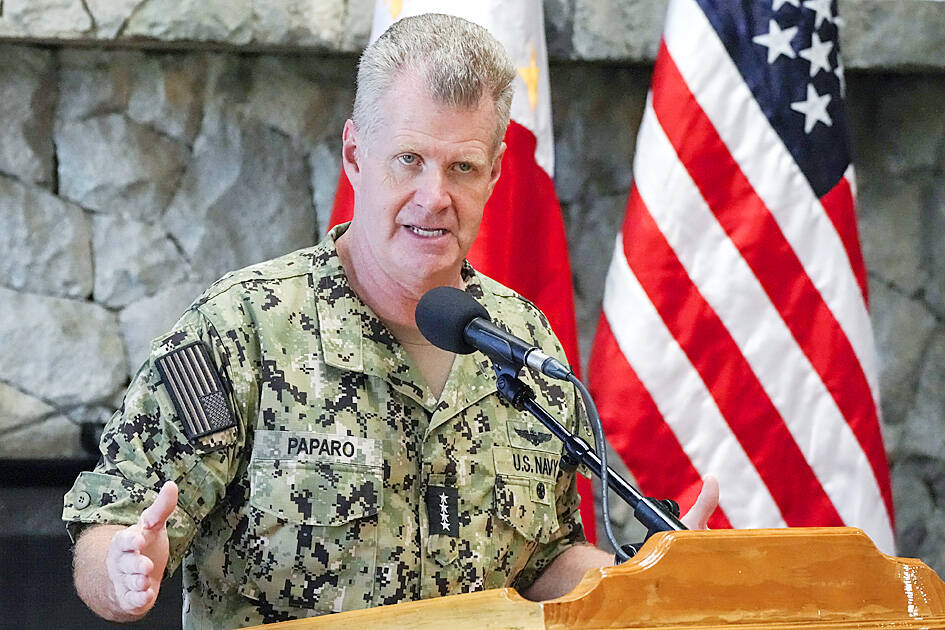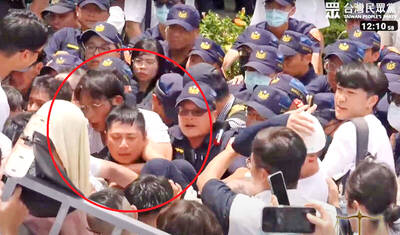US Indo-Pacific Commander Admiral Samuel Paparo on Friday expressed concern over the rate at which China is diversifying its military exercises, the Financial Times (FT) reported on Saturday.
“The rates of change on the depth and breadth of their exercises is the one non-linear effect that I’ve seen in the last year that wakes me up at night or keeps me up at night,” Paparo was quoted by FT as saying while attending the annual Sedona Forum at the McCain Institute in Arizona.
Paparo also expressed concern over the speed with which China was expanding its military. While the US currently would be able to defeat China in a conflict over Taiwan, it is quickly losing that advantage due to China outpacing it in the production of warships and submarines, he said.

Photo: AP
In particular, the US had “key advantages over China in undersea capabilities, as well as superior capabilities in space and weapons that counter space assets, but ... China was building weapons systems, including warships, at a much faster pace than the US,” he was quoted by the FT as saying.
On whether China might be deterred from taking military action against Taiwan, Paparo said it depended on several factors, including the Chinese People’s Liberation Army’s (PLA) level of military readiness, Beijing’s assumptions about Taiwan’s defensive capabilities and the probability of foreign assistance to Taiwan, the FT wrote.
Separately, in an interview yesterday with the Wall Street Journal, US Army Pacific Commanding General Ronald Clark said that five years ago he would not have thought that China today would hold rehearsals of a blockade of Taiwan, “but now it is commonplace.”
“China’s aggressive behavior has made the environment more dangerous” than it was when he was posted in the Indo-Pacific three years ago, he said.
The PLA has since 2022 staged drills to surround Taiwan and simulate cutting it off from the world.
“[These exercises] give us an opportunity to really understand how they would go about something like a blockade or potentially a cross-strait invasion,” Clark said.
The US is building specialized units known as Multi-Domain Task Forces to counter the PLA’s “anti-access/area-denial” capabilities.
Key to this strategy is the new Typhon missile system, Clark said, adding: “If it gives them [Beijing] pause ... let them have it.”

TPP RALLY: The clashes occurred near the Chiang Kai-shek Memorial Hall on Saturday at a rally to mark the anniversary of a raid on former TPP chairman Ko Wen-je People who clashed with police at a Taiwan People’s Party (TPP) rally in Taipei on Saturday would be referred to prosecutors for investigation, said the Ministry of the Interior, which oversees the National Police Agency. Taipei police had collected evidence of obstruction of public officials and coercion by “disorderly” demonstrators, as well as contraventions of the Assembly and Parade Act (集會遊行法), the ministry said in a statement on Sunday. It added that amid the “severe pushing and jostling” by some demonstrators, eight police officers were injured, including one who was sent to hospital after losing consciousness, allegedly due to heat stroke. The Taipei

NO LIVERPOOL TRIP: Taiwan’s Lin Yu-ting, who won a gold medal in the boxing at the Paris Olympics, was embroiled in controversy about her gender at that event Taiwanese boxer Lin Yu-ting (林郁婷) will not attend this year’s World Boxing Championships in Liverpool, England, due to a lack of response regarding her sex tests from the organizer, World Boxing. The national boxing association on Monday said that it had submitted all required tests to World Boxing, but had not received a response as of Monday, the departure day for the championships. It said the decision for Lin to skip the championships was made to protect its athletes, ensuring they would not travel to the UK without a guarantee of participation. Lin, who won a gold medal in the women’s 57kg boxing

‘NOT ALONE’: A Taiwan Strait war would disrupt global trade routes, and could spark a worldwide crisis, so a powerful US presence is needed as a deterrence, a US senator said US Senator Deb Fischer on Thursday urged her colleagues in the US Congress to deepen Washington’s cooperation with Taiwan and other Indo-Pacific partners to contain the global security threat from China. Fischer and other lawmakers recently returned from an official trip to the Indo-Pacific region, where they toured US military bases in Hawaii and Guam, and visited leaders, including President William Lai (賴清德). The trip underscored the reality that the world is undergoing turmoil, and maintaining a free and open Indo-Pacific region is crucial to the security interests of the US and its partners, she said. Her visit to Taiwan demonstrated ways the

The US has revoked Taiwan Semiconductor Manufacturing Co’s (TSMC, 台積電) authorization to freely ship essential gear to its main Chinese chipmaking base, potentially curtailing its production capabilities at that older-generation facility. American officials recently informed TSMC of their decision to end the Taiwanese chipmaker’s so-called validated end user (VEU) status for its Nanjing site. The action mirrors steps the US took to revoke VEU designations for China facilities owned by Samsung Electronics Co and SK Hynix Inc. The waivers are set to expire in about four months. “TSMC has received notification from the US Government that our VEU authorization for TSMC Nanjing